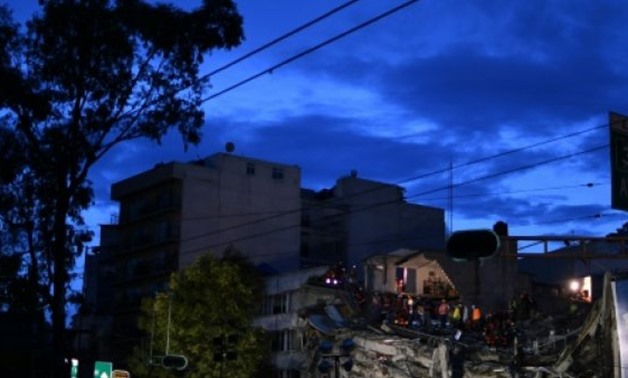
© AFP / by Yussel GONZALEZ con Paulina ABRAMOVICH en Santiago | Tuesday's earthquake, which struck on the 32nd anniversary of the devastating 1985 quake, toppled 39 buildings in Mexico City
MEXICO CITY – 23 September 2017: Sergio Lopez spends his days inspecting buildings at risk of collapse in Mexico City following Tuesday's quake. And he still can't believe that a school where 19 children and six adults died collapsed like a house of cards.
"It just should have stood up. It shouldn't have come down," he says angrily.
Lopez is a structural engineer and he knows the ins and outs of earthquake-resistant construction code improvements as well as anyone.
Those improvements were developed after a 1985 earthquake that killed more than 10,000 people in the capital.
"Back in 1985, the code book was about 80 pages long. Now, it's a massive brick -- like 600-pages long," said Lopez, 55, on his way to an inspection.
Tuesday's earthquake, which struck on the 32nd anniversary of the devastating 1985 quake, toppled 39 buildings in Mexico City.
Some 600 buildings damaged but left standing have to be checked to verify the state of their structure, according to Mayor Miguel Angel Mancera.
Old buildings -
Among the changes authorities put in place after the 32-year-old disaster, which left several areas of this metropolis of 20 million in ruins, is the use of steel-reinforced concrete, as well as weight-bearing regulations.
Also, buildings have to feature mandatory escape routes.
"Before, building meant putting up walls and on those walls they put slabs (roofs). Now they have to distribute the loads," says Jonathan Uraga, a 30-year-old engineer who also checks buildings for possible damage.
Lopez points out that thanks to these new rules, this week's tragedy was not on the scale of the 1985 disaster.
He says that the buildings that fell "either were built before 1985, or, honestly, were poorly built, like the school."
In Tuesday's quake, the neighborhoods hit hardest were the central Roma and Condesa zones, home to many charming buildings from the early part of the 20th century.
Code update -
Despite the tragic toll of nearly 300 dead from the earthquake, Christian Ledezma, a structural engineering professor at the Catholic University of Chile, believes damage to buildings was fairly limited.
"From a distance, when you look at the percentage of the number of buildings that collapsed in the total amount of buildings in Mexico City, it's not a very large percentage," Ledezma told AFP.
Just as Mexico did, Chile tightened its regulations to make buildings more seismically resistant after 1985.
Since then, it has been jolted by a string of major earthquakes including an 8.8 magnitude in 2010 which was followed by a tsunami that killed more than 500 people. After each disaster, Chile updated the code further to include lessons learned, most recently in 2011.
"Chile's code is very recent, and in Mexico it was modified after the earthquake of 1985. Standards were raised, updated to what took place in that earthquake," said Paulina Gonzalez a seismic engineer who teaches at the University of Santiago.
"It happens to us quite a bit in countries prone to earthquakes: standards and codes come as responses to different earthquakes that hit.
"In Chile's case, that's been the case. Every code update came because there was an earthquake that taught us something new," said Ledezma.
Arturo Ramirez, a civil engineer at Mexico City's UNAM (National Autonomous University of Mexico), said that in Mexico the current rules "are very strict precisely because the experiences of recent earthquakes have taught us that there are things to take into account."
"This year, the new regulations of the Federal District were going to come out. But as a result of these events, they are finding new unknowns. And the new code is not going to come out this year, rather in 2018, and it will be one of the world's toughest."
Remodeling woes -
Mexican experts say that part of the problem is that sometimes people living in buildings engage in major renovations that violate city codes on load distribution, among others.
That was in evidence in an apartment building checked by Sergio Lopez a day after the quake.
Because owners want to expand their home, they often do so without regard for what must be load-bearing walls. They take risks they may or may not be aware of.
"They make the changes because they want a more spacious home. But they forget that they are altering the structure" unsafely, risking their lives and those of their neighbors, Lopez says.


Comments
Leave a Comment